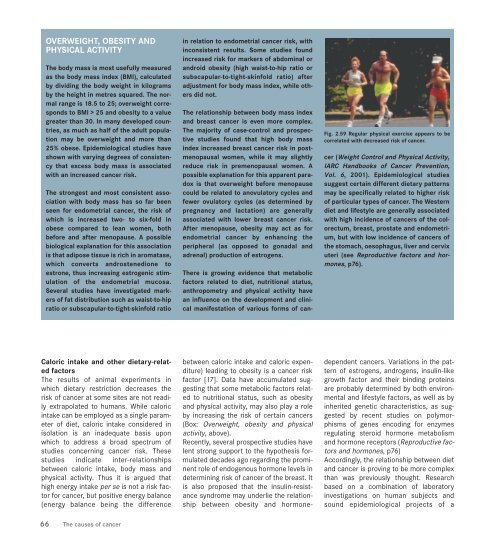world cancer report - iarc
world cancer report - iarc
world cancer report - iarc
Create successful ePaper yourself
Turn your PDF publications into a flip-book with our unique Google optimized e-Paper software.
OVERWEIGHT, OBESITY AND<br />
PHYSICAL ACTIVITY<br />
The body mass is most usefully measured<br />
as the body mass index (BMI), calculated<br />
by dividing the body weight in kilograms<br />
by the height in metres squared. The normal<br />
range is 18.5 to 25; overweight corresponds<br />
to BMI > 25 and obesity to a value<br />
greater than 30. In many developed countries,<br />
as much as half of the adult population<br />
may be overweight and more than<br />
25% obese. Epidemiological studies have<br />
shown with varying degrees of consistency<br />
that excess body mass is associated<br />
with an increased <strong>cancer</strong> risk.<br />
The strongest and most consistent association<br />
with body mass has so far been<br />
seen for endometrial <strong>cancer</strong>, the risk of<br />
which is increased two- to six-fold in<br />
obese compared to lean women, both<br />
before and after menopause. A possible<br />
biological explanation for this association<br />
is that adipose tissue is rich in aromatase,<br />
which converts androstenedione to<br />
estrone, thus increasing estrogenic stimulation<br />
of the endometrial mucosa.<br />
Several studies have investigated markers<br />
of fat distribution such as waist-to-hip<br />
ratio or subscapular-to-tight-skinfold ratio<br />
Caloric intake and other dietary-related<br />
factors<br />
The results of animal experiments in<br />
which dietary restriction decreases the<br />
risk of <strong>cancer</strong> at some sites are not readily<br />
extrapolated to humans. While caloric<br />
intake can be employed as a single parameter<br />
of diet, caloric intake considered in<br />
isolation is an inadequate basis upon<br />
which to address a broad spectrum of<br />
studies concerning <strong>cancer</strong> risk. These<br />
studies indicate inter-relationships<br />
between caloric intake, body mass and<br />
physical activity. Thus it is argued that<br />
high energy intake per se is not a risk factor<br />
for <strong>cancer</strong>, but positive energy balance<br />
(energy balance being the difference<br />
66 The causes of <strong>cancer</strong><br />
in relation to endometrial <strong>cancer</strong> risk, with<br />
inconsistent results. Some studies found<br />
increased risk for markers of abdominal or<br />
android obesity (high waist-to-hip ratio or<br />
subscapular-to-tight-skinfold ratio) after<br />
adjustment for body mass index, while others<br />
did not.<br />
The relationship between body mass index<br />
and breast <strong>cancer</strong> is even more complex.<br />
The majority of case-control and prospective<br />
studies found that high body mass<br />
index increased breast <strong>cancer</strong> risk in postmenopausal<br />
women, while it may slightly<br />
reduce risk in premenopausal women. A<br />
possible explanation for this apparent paradox<br />
is that overweight before menopause<br />
could be related to anovulatory cycles and<br />
fewer ovulatory cycles (as determined by<br />
pregnancy and lactation) are generally<br />
associated with lower breast <strong>cancer</strong> risk.<br />
After menopause, obesity may act as for<br />
endometrial <strong>cancer</strong> by enhancing the<br />
peripheral (as opposed to gonadal and<br />
adrenal) production of estrogens.<br />
There is growing evidence that metabolic<br />
factors related to diet, nutritional status,<br />
anthropometry and physical activity have<br />
an influence on the development and clinical<br />
manifestation of various forms of can-<br />
between caloric intake and caloric expenditure)<br />
leading to obesity is a <strong>cancer</strong> risk<br />
factor [17]. Data have accumulated suggesting<br />
that some metabolic factors related<br />
to nutritional status, such as obesity<br />
and physical activity, may also play a role<br />
by increasing the risk of certain <strong>cancer</strong>s<br />
(Box: Overweight, obesity and physical<br />
activity, above).<br />
Recently, several prospective studies have<br />
lent strong support to the hypothesis formulated<br />
decades ago regarding the prominent<br />
role of endogenous hormone levels in<br />
determining risk of <strong>cancer</strong> of the breast. It<br />
is also proposed that the insulin-resistance<br />
syndrome may underlie the relationship<br />
between obesity and hormone-<br />
Fig. 2.59 Regular physical exercise appears to be<br />
correlated with decreased risk of <strong>cancer</strong>.<br />
cer (Weight Control and Physical Activity,<br />
IARC Handbooks of Cancer Prevention,<br />
Vol. 6, 2001). Epidemiological studies<br />
suggest certain different dietary patterns<br />
may be specifically related to higher risk<br />
of particular types of <strong>cancer</strong>. The Western<br />
diet and lifestyle are generally associated<br />
with high incidence of <strong>cancer</strong>s of the colorectum,<br />
breast, prostate and endometrium,<br />
but with low incidence of <strong>cancer</strong>s of<br />
the stomach, oesophagus, liver and cervix<br />
uteri (see Reproductive factors and hormones,<br />
p76).<br />
dependent <strong>cancer</strong>s. Variations in the pattern<br />
of estrogens, androgens, insulin-like<br />
growth factor and their binding proteins<br />
are probably determined by both environmental<br />
and lifestyle factors, as well as by<br />
inherited genetic characteristics, as suggested<br />
by recent studies on polymorphisms<br />
of genes encoding for enzymes<br />
regulating steroid hormone metabolism<br />
and hormone receptors (Reproductive factors<br />
and hormones, p76)<br />
Accordingly, the relationship between diet<br />
and <strong>cancer</strong> is proving to be more complex<br />
than was previously thought. Research<br />
based on a combination of laboratory<br />
investigations on human subjects and<br />
sound epidemiological projects of a

















